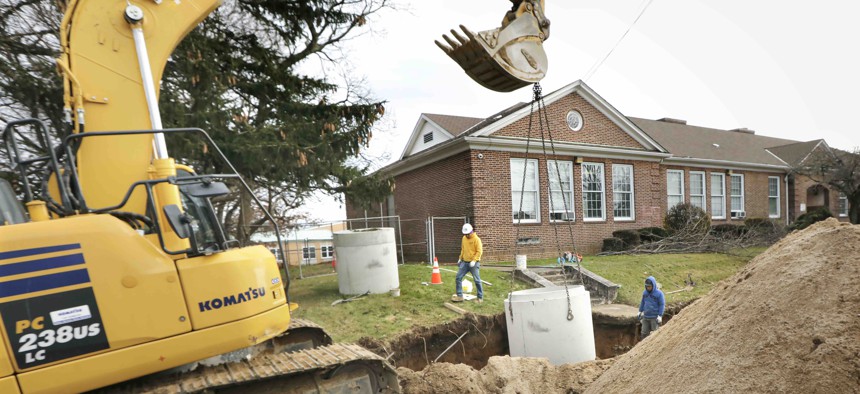Municipal Water Leaders Want More Federal Help for Poor Customers

Workers use heavy machinery to lower a section of concrete pipe into the ground in New York. John Paraskevas/Newsday RM via Getty Images
They say they’re facing an untenable situation as low-income households are pressured by higher rates and systems need major upgrades. One official warns that a recent drinking water failure in Mississippi “is a harbinger of a wider national problem.”
In the wake of a drinking water crisis in Mississippi earlier this year, several municipal water utility leaders called on Congress Wednesday to take a greater role in helping low-income residents pay for their water bills.
The assistance would be similar to how the federal government helps poor people with other utilities, they said, and could help cash-strapped customers cope with water bills that have been rising at twice the rate of inflation since 2000. Those rate increases, the executives noted, are often required to help water utilities comply with federal mandates.
The added money would also put the utilities themselves on better financial footing, which would help them avoid systemic failures of municipal water systems, like the one seen over the summer in Jackson, Mississippi and previously in places like Flint, Michigan, they added.
“Jackson is a harbinger of a wider national problem: the water affordability challenge,” said David Denard, the director of environmental services for the Jefferson County Commission in Alabama, during a call with reporters. “Congress must take this opportunity to address the wider national issue by providing targeted relief to low-income families.”
The residents of Jackson have endured a string of water-related crises in recent years, culminating this summer when a river flooded the city’s water treatment center and residents went seven weeks without drinking water. The city’s inability to maintain quality drinking water—and state officials’ unwillingness to help the city do so—prompted the federal Justice Department to sue both and seek an outside party to run the system in the meantime.
While the situation in Jackson mostly involved drinking water, wastewater and stormwater systems face similar challenges, said Nathan Gardner-Andrews, the chief advocacy and policy officer for the National Association of Clean Water Agencies.
After Congress passed the Clean Water Act in 1972, the federal government provided funding to help municipalities improve their water infrastructure. Among other things, those projects helped prevent contaminated water from sewers from flowing into rivers and lakes when it rained.
But Congress scaled back that help starting in the 1980s, and older systems in particular have struggled to keep up with the mounting costs. The federal government is a key contributor to those costs, as the U.S. Environmental Protection Agency has clamped down on combined sewer overflows and other hazards, often forcing local water agencies to build multibillion-dollar projects to address them.
“There is only so much of this burden financially that we can put on the back of the local ratepayers,” Gardner-Andrews said. “Whereas the federal government used to play a very significant role in helping to fund these infrastructure investments, that investment has really disappeared in the last two decades.”
The federal government spent 7.5 times more per person on water infrastructure in 1977 compared to 2014, according to NACWA.
The water executives touted the assistance programs that they already offer low-income customers, but those discounts are funded by other ratepayers, they noted.
Without extra help, “communities like Buffalo that have high poverty rates are going to be stuck in that same doom loop cycle of not being able to afford the needed [service],” said Oluwole “OJ” McFoy, the general manager of the Buffalo Sewer Authority in New York.
Thirty percent of the sewer authority’s customers live below the poverty rate, McFoy pointed out. The same customer base has to support $500 million improvements to reduce sewer overflows and a similar amount for replacing lead pipes in its drinking water system. While the federal government has provided infrastructure money to address those issues in recent years, “they are just a start,” he said.
The clean water group is exploring several ways that the federal government could help low-income customers, Gardner-Andrews said.
One possibility is to expand a program created in the wake of the Covid-19 outbreak. The Low Income Household Water Assistance Program is run by the federal Department of Health and Human Services. It was modeled on a popular program to help people with their energy costs, he said. But the water sector works differently than the electric industry, causing several “challenges” that would need to be addressed going forward.
Separately, Congress created a program to assist low-income water customers in last year’s infrastructure law that would run through the EPA. But Congress never passed any funding for it.
Kyle Dreyfuss-Wells, the CEO of the Northeast Ohio Regional Sewer District that serves the Cleveland area, cautioned that any program designed to help low-income customers needed to offer straightforward access for participants.That goes for all kinds of assistance programs, not just water relief, she stressed.
Customers who wanted to qualify for the water-related assistance from the Covid-relief laws had to present copies of the birth certificates for all the members of their household. Copies of those birth certificates cost $25 a piece, and they could only be obtained during business hours.
“You have to take off work, you have to go to city hall, then you have to go to the community assistance group that’s helping you do this,” she said. The situation is even more complicated for people who don’t speak English as their first language, she added. “These are barriers that we at the sewer district are knocking down one after the other, but we have found that it is intensive.”
Daniel C. Vock is a senior reporter for Route Fifty based in Washington, D.C.
NEXT STORY: Cyber, digital services, workforce primary focus for state CIOs in 2023






